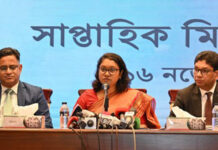
A brisk rain washed the leaf litters from the hillsides within the national park of Lawachhara. Cracking sounds of the forest garbage rolling down the hills could be heard from quite far. Smell of newly wet soil was still there in the environs of the forest rest house. It was the last week of July 2013. As we stepped out of the forest rest house, deafening sounds of the Litter frogs which are much smaller than the toads we see at our homes and countryside houses greeted us. They had just popped out of their hiding in tree trunk holes and hollows. They informed the world around that they were all awake and ready to jump into their real life of food gathering or raising families.
My objective was to look for toads and frogs making hay on fruitful nights of the rainy season, as all of them need water to take part in courtship and egg-laying. This is followed by production of tadpoles that must grow up in an aquatic environment, be that natural or man-made. Or even under and within the skin of the mother toad, as is the case with the South American Surinam Sea Toad.
We waited for a local guide to help us move through the pitch dark night of Lawachhara. The guide was a local Tipra man, who never turned up. It was almost an hour after sundown. Our rest house man was out in the market to get rations for our dinner and breakfast. In the absence of a guide when we decided to move on our own through the forest, the wife of the rest house attendant told us she was too afraid to remain alone and so came down with us up to the residences of the other forest staff when we moved downhill following a chhara, just below the mosque by the rail crossing.
Litter frogs were calling from all directions but appeared beyond our reach. The common tree frog could be seen and heard from every direction. The maculated tree frog call echoed over chhara water, reminding us of the gurgling of a person with a sore throat.
I was accompanied by Tania Khan, a self-made wildlife researcher; forest department officer Ishrat Jahan and our too young field guide and the most enthusiastic field companion Rafiq, who almost always accompanies Tania in all her field work.
I had with me half a dozen head lamps and torchlights that I usually shared with the others who accompanied me. Rafiq is a great animal spotter. He saw a tiny frog amongst low foliage. As it was too small and I could not bend with my heavy body and loads of cameras to take shots, he caught it and gave it to me. I took it on my left thumb and just took two shots considering it to be an ordinary froglet of some unknown species.
Recently I was sifting through old pictures to take out amphibian, reptile, bird and mammal pictures for use in a checklist book of mine that is to be published soon. Among the Lawachhara pictures I have saved in the external hard disk I found a tiny frog sitting on my left thumb. I failed to tally it with all the pictures of Indian frogs and those from Bangladesh published in deshi and foreign internet sites. So, I sent both shots to Dr. Firoz Ahmed of Guwahati, Assam, India. He is a herpetologist and has helped me in the past in identifying several species. Soon, he replied, identifying it as a species of Micryletta and genuinely not sure which one of the two it could be. A species of it called Micryletta inornata, also known as Deli Paddy Frog, False Ornate Narrow-mouthed Frog, Deli Little Pygmy Frog, Inornate Froglet, et cetera.
As I searched through the internet I found the genus Micryletta had been separated from the more commonly known Microhylain in 1987 by a French biologist named Allan Dubois. However, it was found as Microhyla inornata in 1890 when the British biologist Boulenger wrote an article about a collection of animals from Indonesia and Taiwan (Boulenger, G. A. 1890. List of the reptiles, batrachians, and freshwater fishes collected by Professor Mosh and Mr. Viersen in the district of Deli, Sumatria.] in the Proceedings of the Zoological Society of London.1890: pages 30–39. The 2nd one and its only cousin Microhyla steinegerior Stejneger’s Paddy Frog, Stejneger’s Narrow-mouthed Toad, Paddy Frog, Taiwan Little Pygmy Frog was found in 1909 by Boulenger himself (Microhyla steinegeri Boulenger, 1909, Ann. Mag. Nat. Hist., Ser. 8, 4: 494. Syntypes: BMNH 1909.10.29.92-96 according to Parker, 1934, Monogr. Frogs Fam. Microhylidae: 145. Type locality: “Kanshirei”, Taiwan, China).
An Indian biologists Pillai in 1977 discovered Inornate Froglet’s sample in the Andaman island chain of India. IUCN considers it as native to Cambodia; China; India (Andaman Is.); Indonesia (Sumatra); Lao People’s Democratic Republic; Malaysia (Peninsular Malaysia); Thailand and Viet Nam.
The froglet I found in Lawachhara cannot be Stejneger’s Paddy Frog as it is endemic to Taiwan. But the Inornate Froglet is the one that has at least been found in the Andamans if not in Manipur. Even if it is found in Manipur it is definitely too far for a tiny frog to make a cross country race to reach Lawachhara from there.
I am temporarily considering the forglet I have found in Lawachhara to belong to this Inornate Froglet. It could be the tiniest frog of our country as it hardly measures 20mm or 2cm, less than an inch in length from the tip of the snout up to the anal opening. Boulenger when describing the species first gave the measurement of two males and one female collected from Sumatra, Indonesia, as 20mm when others gave the length as 23 to 33 mm. It has an indistinct tympanum that is absent in the Microhyla species. Also, its overall appearance is rectangular when Microhylids are triangular in shape.
This frog has very variable colour formation. The one on my thumb resembles the lighter ones with dark broad, broken lines and some large dark blotches over the back. Chin and gape-line having yellow tinges. Overall pale brown back and whitish underside.
The colour pattern and its sudden presence in Lawachhara indicate three distinct possibilities: it could be a new species of Micryletta genus; it is a new subspecies of existing Micryletta inornata and there could be other populations of it present in Indian States bordering Bangladesh; the population in Lawachhara, Bangladesh became isolated from the South-East Asian population possibly thousands of years back.
Whether this Lawachhara Inornate Froglet belongs to Micryletta Inornata or a different species, it is definitely related to it, which means millions of years back the land of Bangladesh was historically/geologically connected to the land extending up to Indonesia.
None of Bangladeshi scientific papers or books I have found so far has ever mentioned the occurrence of Micryletta Inornata in Bangladesh. Also, no Indian amphibian biologist has mentioned it to be present anywhere in India, other than the Andamans.
So, Micryletta Inornata does not only represent a new species for Bangladesh amphibian fauna; it does include a genus- Micryletta- as well.
Source: The Daily Star









